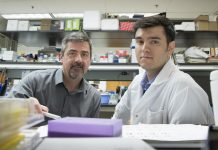February 2005 - In an attempt to find a new generation of diabetic drugs that will minimize side effects, researchers at the University of Pennsylvania School of Medicine report a new understanding of how thiazolidinediones (TZDs), widely used diabetic medications, work in fat cells. With yearly sales exceeding billions of dollars, TZDs � such as rosiglitazone maleate (Avandia) and pioglitazone hydrochloride (Actos) � help to maintain diabetics' blood-sugar levels.
In fat cells, TZDs turn on a small set of genes, which aren't normally turned on, by targeting the receptor PPAR�. To tease out how the medications work specifically, the investigators set out to determine the difference between the genes that are ordinarily turned on in fat cells and the genes that are turned on only when diabetics are given the TZDs.
A new study from the laboratory of Mitchell Lazar, MD, PhD, Director of the Institute for Diabetes, Obesity, and Metabolism at Penn, has found that PPAR� can turn genes both on and off. "What regulates it, in this case, is the drug, which is acting as a switch to turn genes on," says Lazar. "This paper shows that we can separate the two different aspects of the drug's action on fat cells." These findings appeared in the January 28th online edition of Genes & Development and the February 15th print issue.
Knowing how to turn a gene off may permit researchers to develop drugs that would decrease TZD-related side effects such as weight gain and edema. Indeed, preclinical research is already underway to design drugs called SPPARMs, selective PPAR� modulators, which would specifically target genes in fat cells that can turn off the molecular pathways that may lead to these serious side effects.
Working with mouse fat cells, Lazar's study suggests that one way to get gene-selective actions would be to target this ability to turn off genes without affecting the ability to turn others on. "Since these are separate processes, one through one type of molecular action and one through another, our work shows that this is feasible," says Lazar
Continue Reading Below ↓↓↓
How would a SPPARM work? TZDs turn genes on and off by working with molecules called coactivators and corepressors. In addition to its beneficial role, TZDs turn fibroblasts into fat cells by enlisting more coactivators than normal, thus leading to weight gain. The goal is to design a SPPARM that will reduce interaction with corepressors, but increase interaction with coactivators, to separate anti-diabetic effects and weight gain.
"We should be optimistic about finding a new type of drug with the same fat-cell target as TZDs, but which is a selective regulator of gene expression in such a way that will increase the benefit-to-risk ratio of the diabetes treatment," says Lazar.
This research was funded in part by the National Institutes of Health and an unrestricted Bristol Myers Squibb Freedom to Discover Award in Metabolic Research. Other Penn investigators contributing to this research are: Hong-Ping Guan, Takahiro Ishizuka, and Patricia C. Chui, and Michael Lehrke. The authors report no conflicting financial interests.
Source: University of Pennsylvania Medical Center










